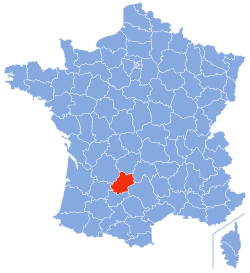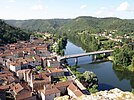Lot
Òlt (Occitan) | |
|---|---|
From top down, left to right: Figeac, Rocamadour, Faycelles, Lot River, prefecture building in Cahors and Luzech | |
 Location of Lot in France | |
| Coordinates: 44°35′N 01°35′E / 44.583°N 1.583°E | |
| Country | France |
| Region | Occitanie |
| Prefecture | Cahors |
| Subprefectures | Figeac Gourdon |
| Government | |
| • President of the Departmental Council | Serge Rigal[1] |
| Area | |
• Total | 5,217 km2 (2,014 sq mi) |
| Population (2021)[2] | |
• Total | 174,942 |
| • Rank | 93rd |
| • Density | 34/km2 (87/sq mi) |
| Time zone | UTC+1 (CET) |
| • Summer (DST) | UTC+2 (CEST) |
| Department number | 46 |
| Arrondissements | 3 |
| Cantons | 17 |
| Communes | 313 |
| ^1 French Land Register data, which exclude estuaries, and lakes, ponds, and glaciers larger than 1 km2 | |
Lot (French pronunciation: [lɔt];[3] Occitan: Òlt [ɔl]) is a department in the Occitanie region of France. Named after the Lot River, it lies in the southwestern part of the country and had a population of 174,094 in 2019.[4] Its prefecture is Cahors; its subprefectures are Figeac and Gourdon.
History
[edit]Lot is one of the original 83 departments created during the French Revolution on 4 March 1790. It was created from part of the province of Quercy. In 1808 some of the original southeastern cantons were separated from it to form the department of Tarn-et-Garonne. It originally extended much farther to the south and included the city of Montauban.
Geography
[edit]
Lot is part of the region of Occitanie and is surrounded by the departments of Corrèze, Cantal, Aveyron, Tarn-et-Garonne, Lot-et-Garonne and Dordogne. It is named after the river Lot, which in its Occitan name is Olt.
Cahors is the prefecture of the department, lying in its southwestern part: a medieval cathedral town known internationally for its production of Cahors wine, it lies in a wide loop of the Lot River and is famous for its 14th-century bridge, the Pont Valentré. Figeac is a medieval town where Jean-François Champollion, the first translator of Egyptian hieroglyphics, was born, situated in the eastern part of Lot. Gourdon, a medieval hilltop town located in Lot's northwestern part, with a well preserved centre, comprises many prehistoric painted caves nearby, notably the Grottes de Cougnac.
Principal towns
[edit]The most populous commune is Cahors, the prefecture. As of 2019, there are seven communes with more than 3,000 inhabitants:[4]
| Commune | Population (2019) |
|---|---|
| Cahors | 19,937 |
| Figeac | 9,802 |
| Gourdon | 3,981 |
| Pradines | 3,562 |
| Gramat | 3,469 |
| Saint-Céré | 3,414 |
| Souillac | 3,201 |
Demographics
[edit]The inhabitants of Lot are called Lotois and Lotoises in French. Population development since 1801:
|
| ||||||||||||||||||||||||||||||||||||||||||||||||||||||||||||||||||||||||||||||||||||
| |||||||||||||||||||||||||||||||||||||||||||||||||||||||||||||||||||||||||||||||||||||
| Sources:[5][6] | |||||||||||||||||||||||||||||||||||||||||||||||||||||||||||||||||||||||||||||||||||||
Politics
[edit]Departmental Council of Lot
[edit]The Departmental Council of Lot has 34 seats. Since the 2015 departmental elections, 30 are controlled by the Socialist Party (PS) and its allies; four are controlled by the miscellaneous right. Since 2014, the President of the Departmental Council has been Serge Rigal, currently a member of La République En Marche! (REM).
Members of the National Assembly
[edit]Lot elected the following members of the National Assembly during the 2017 legislative election:
| Constituency | Member[7] | Party | |
|---|---|---|---|
| Lot's 1st constituency | Aurélien Pradié | The Republicans | |
| Lot's 2nd constituency | Huguette Tiegna | La République En Marche! | |
Senators
[edit]Lot is represented in the Senate by Angèle Préville (since 2017) and Jean-Claude Requier (since 2011).
Tourism
[edit]See also
[edit]References
[edit]- ^ "Répertoire national des élus: les conseillers départementaux". data.gouv.fr, Plateforme ouverte des données publiques françaises (in French). 4 May 2022.
- ^ "Téléchargement du fichier d'ensemble des populations légales en 2021" (in French). The National Institute of Statistics and Economic Studies. 28 December 2023.
- ^ "lot - Deutsch-Übersetzung - Langenscheidt Französisch-Deutsch Wörterbuch" (in German and French). Langenscheidt. Retrieved 22 October 2018.
- ^ a b Populations légales 2019: 46 Lot, INSEE
- ^ "Historique du Lot". Le SPLAF.
- ^ "Évolution et structure de la population en 2016". INSEE.
- ^ Nationale, Assemblée. "Assemblée nationale ~ Les députés, le vote de la loi, le Parlement français". Assemblée nationale.
External links
[edit]- (in French) Prefecture website
- (in French) Departmental Council website
- (in English) hiking the Tour du Lot
- (in French) CazalRando groupe de randonnée pédestre website












